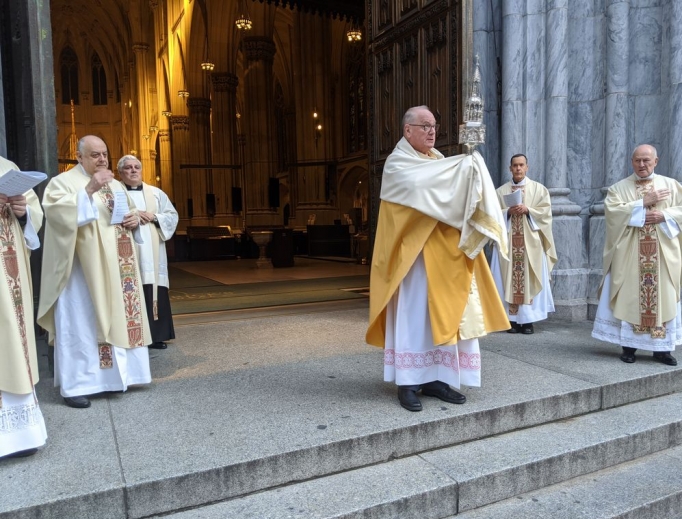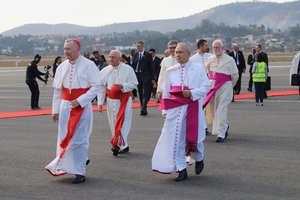Shepherding New York City’s Faithful, in the Heart of the Coronavirus Pandemic
Local priests and deacons tell the Register about the challenges they’ve faced ministering to their flocks during this painful period.

NEW YORK — Nothing is small in the city of New York. Everything that happens here seems to happen in the biggest way and in the largest size — including the coronavirus pandemic.
When it comes to the pandemic, it has hit the Archdiocese of New York hard and left it shocked and shuttered. Every parish stopped public Masses on March 14. All Catholic schools are closed until September. There is no hard date as to when things will reopen, though most believe that churches may reopen in a limited way sometime in July.
In some boroughs of New York City, like Queens, the Bronx and Brooklyn, all anyone could hear outside their windows for weeks was the sound of ambulance sirens blaring all day long.
“Three months ago, I would never have imagined that this was possible,” said Father Salvatore DiStefano, pastor of the parish of St. Clare’s/St. Francis Xavier in the Bronx. “It feels like something out of a bad science-fiction movie.”
In the middle of Manhattan — an area known for traffic, noise and crowds — Father Gerald Murray, pastor of the Church of the Holy Family, says that the streets are silent.
“It is amazingly quiet,” said Father Murray. “The United Nations campus, which is across the street, is closed. There is no activity. Nobody is around. You can hear birds chirping.”
For Father Thomas Vassalotti, pastor of Divine Mercy parish in Brooklyn, the entire experience has been jarring.
“It is very different and surreal,” said Father Vassalotti. “It happened so quickly. It was shocking.”
Deacon Greg Kandra, from Our Lady, Queen of Martyrs parish in Queens, lives 2 miles away from Elmhurst Hospital Center. This hospital has been called the “epicenter of the epicenter” because it has had the highest number of COVID-19 patients. Staff also needed to place the bodies of the dead in a refrigerated truck parked out front.
“Everybody in my circle of friends knows someone who has gotten sick from coronavirus and died. It has shaken everybody up,” said Deacon Kandra. “We have all felt frustrated because what we are allowed to do is not much. Hispanic people have been hit very hard. One Hispanic deacon recently died.”
Painful Separations
For every priest interviewed, the worst part has been having to be physically distant from parishioners who were sick and dying.
“Many people in my parish went to the hospital,” said Father DiStefano. “It was terrible to get a call and get asked if I could anoint someone who was dying and have to say, ‘I can’t.’ One of the great parts of being a priest is to accompany people in their final moments, and it has been horrible to not be able to do that.”
Father Distefano’s parish lost two dozen people to coronavirus. Though he was not able to celebrate funerals, he was able to conduct graveside prayer services. Privately, Father Distefano said Masses for everyone who died.
“It has been very difficult. At first, when they announced the lockdown, it seemed a bit drastic, but we had to do it,” he said. “I hope it will be temporary.”
Father Murray’s parish did not have many cases of coronavirus, but the few that occurred hit very close to home.
“On March 10, I had a meeting with one of my parishioners and a couple of diocesan officials on financial matters. The meeting was at the apartment of this parishioner who is in her 90s, whom I sat next to. On March 17, I got a note that she was in the hospital with coronavirus. I had seen her on March 13 at daily Mass. At that point, I sent my parish staff home and went into self-isolation. I also had the church deep cleaned by a company,” said Father Murray.
Meanwhile, on March 11, Father Murray had a meeting with parents of his confirmation candidates. He learned later that the mother who sat next to him also got coronavirus. He ended up staying 14 days in self -quarantine. Both parishioners recovered, and Father Murray ended up remaining healthy. He tested negative for the coronavirus antibody.
One common lament among all priests is that this coronavirus seems to have targeted their seniors, who were heroic Catholics.
“It is the passing of a generation of Catholics known for their devotion and commitment to the Church,” said Father Vassalotti, who noted that in the 1950s — in New York City — Catholics would introduce themselves by which parish they belonged to.
“We lost seven of our seniors to coronavirus. One was Vito Brancato, a veteran of World War II. He was 99 and still going to Mass every day with his home attendant. He had participated in the cleanup of Normandy. He remembered when Joe DiMaggio broke [baseball’s hitting streak] records. His son, who was a firefighter, also died on Ascension Thursday,” said Father Vassalotti.
Every priest has had to reinvent his way of ministering to his parishioners during this pandemic. For Father Murray, it has been through the internet, by conducting a Bible study over Zoom with parishioners. His parish has been helping a food pantry on the West Side.
Father Vassalotti makes personal phone calls to his parishioners, especially the homebound.
“We call every two weeks and occasionally shop for them. We also livestream our Sunday Mass on YouTube,” he said. “We have been Zooming our CCD classes and a parish Bible study. Interestingly enough, we now have triple the number of attendants for our Bible study than before the pandemic.”
For New Yorkers who are used to a very fast pace of living, in some cases at frenetic speed, this slowdown has given many time to reflect.
“It is disorienting,” said Father Vassalotti. “On one hand, this is how life used to be. This slowing down has me calling more people. We can learn lessons from this.”
This pandemic is also a moment when people are questioning the purpose of life. For Catholics, it is a moment to look again at what the faith ultimately means.
“There must be a basis for living an authentic life, and that authentic revelation of what life is about comes from Jesus. The love that he demonstrates by his life is supremely sacrificial love. Jesus’ self-offering — the cross — is very difficult for us to embrace — yet we are people of faith,” said Father Vassalotti.
When Father Vassalotti looks at the example of people he has personally lost to coronavirus, who lived their faith until the end, he sees people who lived authentic, holy lives.
“Love is a decision, informed by the example of Jesus.”
Register correspondent Sabrina Arena Ferrisi writes from New York.
New Guidelines for the Archdiocese of NY
On May 2, the Archdiocese of New York announced a five-phase reopening plan based on Centers for Disease Control guidelines while respecting the Catholic faith. The archdiocese was careful to spell out, “Our people believe that worship is an essential service.” This was a direct rebuke to the New York state plan for reopening, which initially never discussed how house of worship would reopen. The phases are:
Phase I — Churches Open for Private Prayer and Confessions
Phase II — Celebration of Baptisms and Marriages (limited to 10 attendees)
Phase III — Celebration of the Rite of Distributing Holy Communion Outside of Mass
Phase IV — Celebration of Daily and Funeral Masses With Limited Attendance
Phase V — Celebration of Sunday Mass With Supervised Attendance
Resumption of Full Parish Mass Schedules and Sacramental Activities
No dates have been given as to when these phases will begin for New York City. The seven counties north of New York City began Phase 1 on May 26.
Procedures for reopening include:
- Churches must be regularly sanitized.
- Attendance at each Mass will be limited to 25% of physical occupancy of the physical space.
- All parishioners must wear face masks.
- No physical contact will be done during the Sign of Peace.
- Ushers will wear face masks and coordinate entrance and exit of parishioners.
- Pews will be set aside for singles, couples and families. There must be 6-feet distance between families.
- Hand-sanitizer dispensers will be placed at church entrances. Frequently touched surfaces will be cleaned after every liturgy.
- Use of basement and parish centers can be used for overflow with live video feeds.
- Holy water and baptismal fonts will be emptied.
- Additional Mass times may be added.
- Communion will be distributed only via the Host, not the Precious Blood.
- A cantor will be permitted, but no large choirs.















